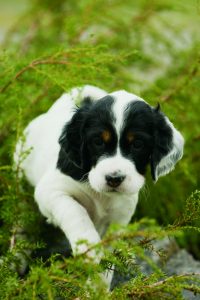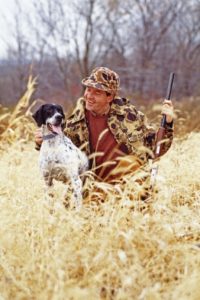Decision Time
by Steve Smith
 For pro breeders and trainers, it seems as though it’s nothing: A pup’s whelped, gets old enough to start training, the pro figures out the dog’s individual personality, and goes on automatic pilot from the first “come” command, to steadiness to wing, shot, and fall. The rest of us, well….
For pro breeders and trainers, it seems as though it’s nothing: A pup’s whelped, gets old enough to start training, the pro figures out the dog’s individual personality, and goes on automatic pilot from the first “come” command, to steadiness to wing, shot, and fall. The rest of us, well….If the average pointing dog person counts up the number of dogs that he’s trained in his lifetime, it’s really painfully few. I’d guess that it’s the rare amateur with a full-time job and time to train and hunt on weekends who has more than maybe a half-dozen to eight dogs in his lifetime, unless a run of bad luck takes them from him at an early age. But if you’re lucky enough to get long, productive lives out of your dogs, then you don’t have that many that pass through your kennel – or, more likely, across your couch.
So to a great extent, every pup is like starting over, and if your memory is like mine, the starting over doesn’t just mean what you teach the pup – it means remembering how you’ll do it, in what order, and what sort of progress you should expect to be making. We have people tell us that they let their PDJ subscription lapse, but then they got a new pup and started reading it again and they bought some DVD’s and re-read their training books and got on website discussion rooms to refresh their memories.
But the need for a new dog as a replacement for one that’s gone or as a youngster to spell your old-timer is his declining years should give us pause to consider other things as well. For example, what about breed? Is this the time to change to one you’ve always admired but never owned? Maybe your hunting tastes have changed: You got your setter 14 years ago when you did a lot of grouse and woodcock hunting, but the last few years you’ve been going after pheasants more and more – do you stick with a setter or seriously look at a shorthair, for example? Maybe you were kidnapped in the middle of the night and forced to go duck hunting and found that you like it for a change of pace – not enough to get a Lab, but maybe enough for a wirehair that can serve in both the uplands and lowlands.
I have said this before, but I think we too often get breed-blind without considering that good dogs regardless of breed have the same attributes in common – nose, drive, intelligence, biddability, and trainability. So Suzie the Brit and Candy the pointer, if they possess these traits, are sisters under their skins.
But not everyone feels that way, and some people won’t consider anything except the breed they’ve always had, and that’s fine. But we know that not all lines within a breed are the same, so many of us go right back to the same breeder of the same breed. Also fine. It’s comfortable, the type of dog you’ll get is pretty well-known, and since you were happy in the past, you’re likely to be happy in the future.
In a way, getting a new pup is like getting a new car or truck – some like to try something different every five years
or so, some go back to what’s worked, just the newest model of the same thing. Either way is fine. I switched from setters to a pointer with my last pup, and I’ve been very pleased. Next time maybe a shorthair, who knows? (I will, however, buy the same model truck next time – I’m not taking any chances!)
Speaking of breeders, one I have known for years is Jim Nelson – JD or “Doc” to his friends. JD’s the town doctor in Elm Creek, Nebraska, and he’s a dedicated pheasant and quail hunter thereabouts, but he hunts all over the country. He also owns Plumthicket Kennels, and he’s bred, raised, and trained a lot of different breeds, including individuals of some imported from the UK and Europe.
When there’s a litter on the ground at Plumthicket, JD gets a lot of calls asking questions; he wishes the callers would ask more or different ones: “It seems that the more someone wants a pup from a litter, the less likely they are to ask me the things they should be concerned about.”
Since the last time you got a pup, some things may have changed. One of those things is the Internet, a fad that in my studied opinion has a pretty good chance of catching on. There are discussion rooms and bulletin boards and I don’t know what all where opinions are shared, arguments joined, and takes given and taken. A lot of this happens under the cover of anonymity, giving the poster (the person writing the stuff) the opportunity to re-invent himself. There are also here and there some guys who just like to stir up trouble and be insulting. That’s the downside.
The upside is that you can learn a lot about what’s current in terms of lines of dogs, good breeders, new gadgets, and so forth in a very short period of time.
For example, on our PDJ discussion board, we’ve got some pretty savvy folks, and if you ask about a breed or a breeder, you are likely to get a number of straight answers. It’s possible for them to reply to a posted question with a private e-mail, which we encourage should the information to be relayed be less than complimentary. Plus, since our board is for subscribers only, we have no jerks hanging out – it’s more like a club. If this sounds like I’m trying to get you to log on and tune in, how perceptive of you.
When it comes to the training regimen, maybe you’re ready to make a change. Was your last dog collar-trained? If not, you may want to consider it this time around. You’ve read a lot about force-fetch but you’ve never done it – is this the dog where you get the retrieving thing down pat? Will your training on birds take a different form from what you’ve done in the past? When I got Sam my pointer, I decided that she was going to be worked on wild birds only. I’m lucky to live where there are some. It’s worked out great.
Maybe you’ve decided to follow the advice of Rick Smith or George Hickox or our other talented columnists in their books or videos or in the magazine; not that they are in disagreement, but their methods vary, and all of them are right. Does it make sense to join a training group so your dog can watch what’s going on tethered with the rest of the chain gang? What about joining NAVHDA? Have you thought about using this new pup for NSTRA or NBHA competition? Is running in an occasional fun trial out of the question? Maybe you think your dog will be a world-beater on pheasants if that’s all he ever hunts. Is this the dog you really finish: honoring; steady to wing, shot, and fall; retrieving to hand? That’s a lot of decisions and a lot of ground to cover.
There’s an old saying about kids I remember from my teaching days: “You are what you were when you were ten.” I always thought it was about 12, but the thrust of the idea is that the values and nearly all of the important skills are pretty well in place at a young age, and the changes in course to come are merely directional shifts to allow for the winds of experience. I think it’s that way with dogs and their amateur trainers. I think that by the time a dog’s three years old, he’s pretty much the dog he’s going to be. Sure, he’ll get more experience and learn to be a little wiser about the birds, and about that time you’ll notice that he’ll start to pace himself. But those are things he teaches himself, which defines experience. His formal training, though, is about as complete as it’s going to get.
The decisions we make before that pup even comes home with us are the ones we and he are going to have to live with for the next, hopefully, 13 to 15 years. It’s a good idea to take a little time making them.
This article originally appeared in the March/April 2008 issue of The Pointing Dog Journal.





